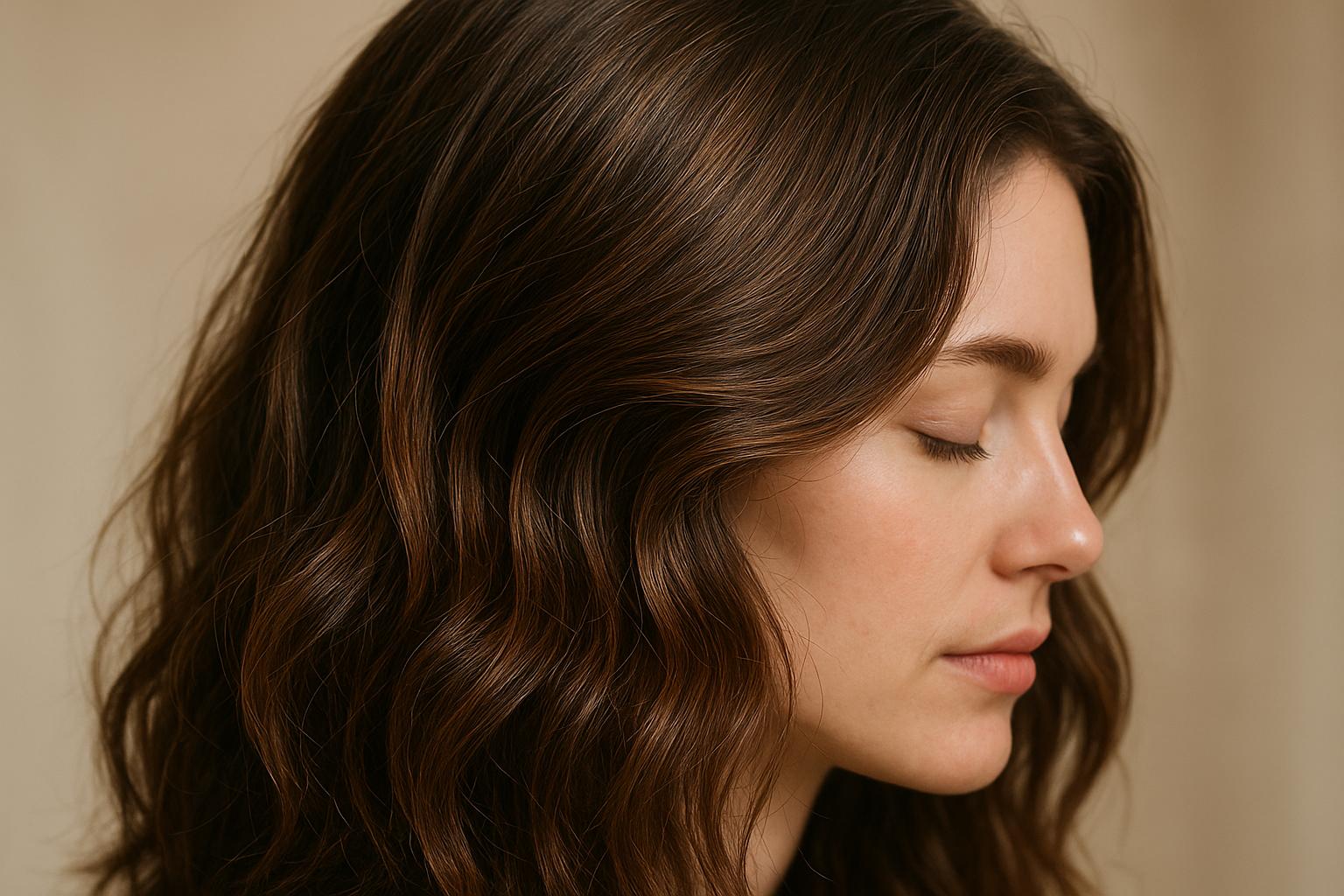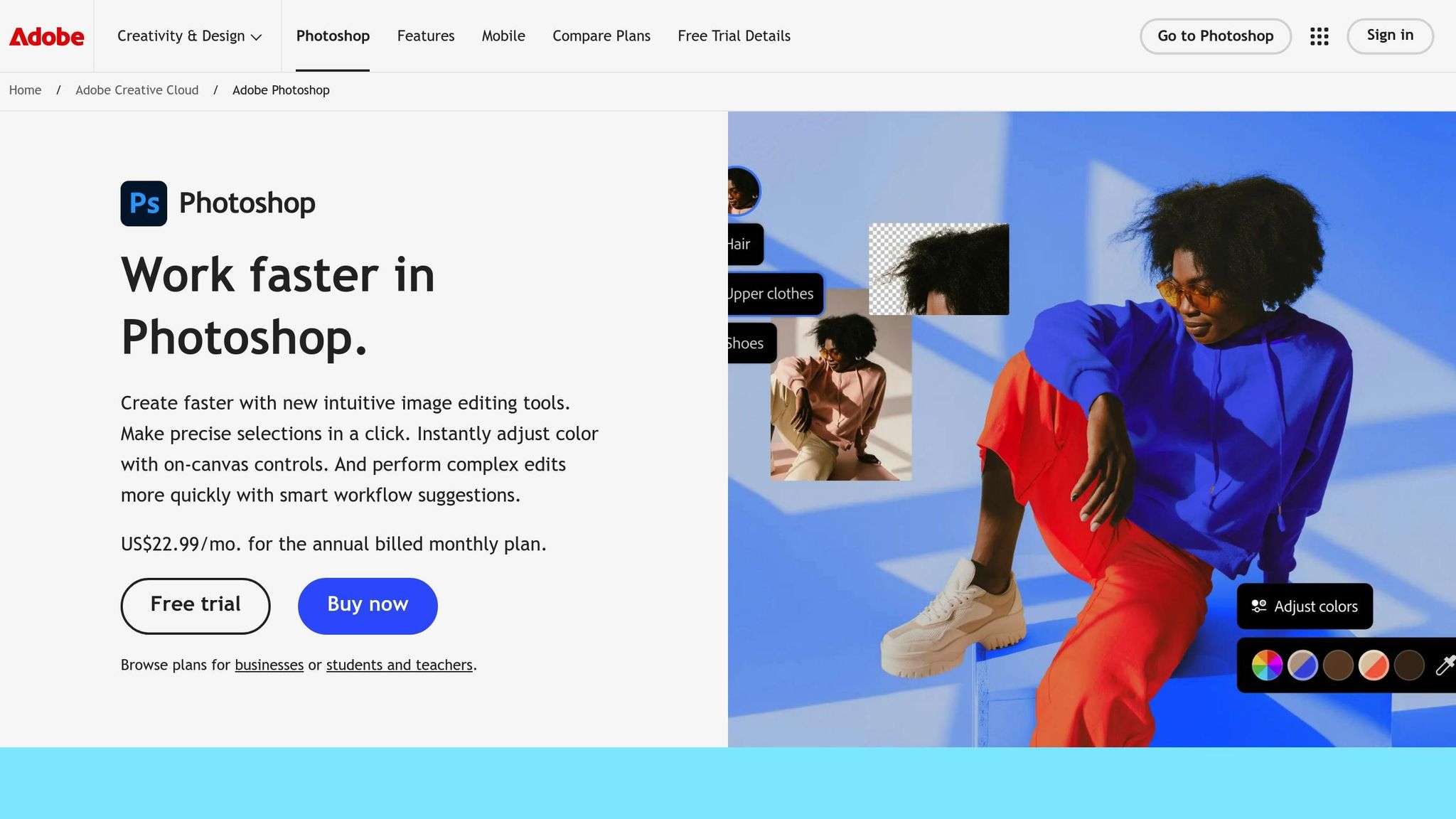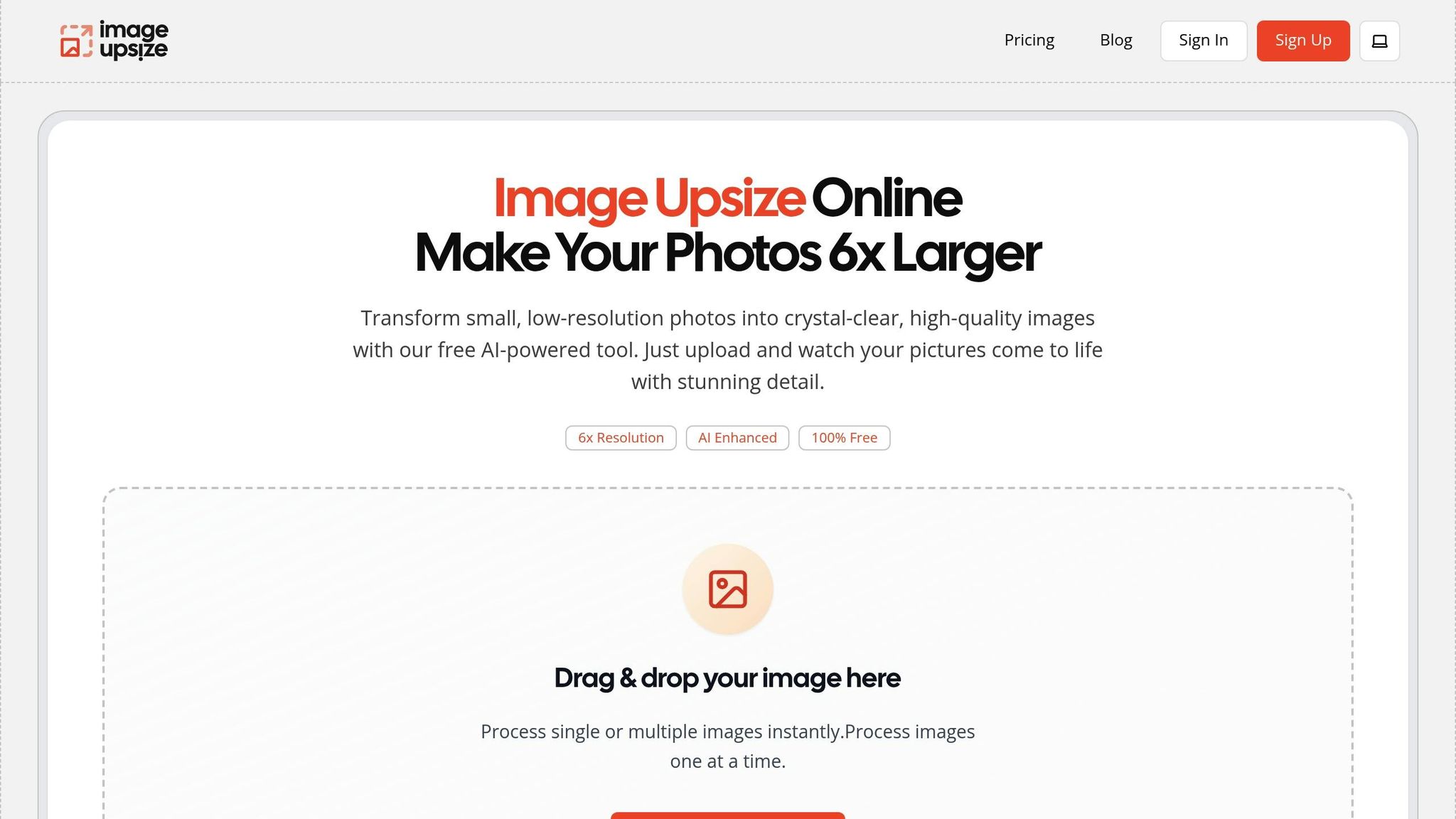How AI Improves Hair Texture in Photos
Explore how AI technology enhances hair texture in photos, restoring details and achieving realistic results with ease.

How AI Improves Hair Texture in Photos
AI has transformed how we edit hair in photos, making it easier to achieve natural, lifelike results. Traditional methods often fail to capture fine strands or create realistic textures, leaving hair looking flat or overly smooth. AI solves these problems by analyzing millions of hair patterns and reconstructing details at the pixel level. It restores missing strands, adjusts for lighting issues, and tailors results to different hair types - whether straight, curly, light, or dark.
Key benefits include:
- Restoring fine details like flyaways and baby hairs lost during compression.
- Fixing lighting issues, such as overexposed highlights or shadowed areas.
- Avoiding the artificial look caused by manual editing tools.
- Adapting to different hair textures for realistic outcomes.
AI tools like ImageUpsize further enhance hair by upscaling images up to 6x their size while preserving intricate details, making them ideal for low-resolution or compressed photos. Whether you're a professional photographer or a casual user, AI offers a quick and effective way to improve hair texture in digital portraits.
AI-Powered Tools for Hair Retouching in Photoshop 🖌

Common Problems with Hair Texture in Digital Photos
Even the most skilled photographers and editors run into recurring challenges when capturing and editing hair in digital portraits. These problems arise from both the technical limitations of cameras and the complexity of replicating the intricate details of natural hair. Recognizing these hurdles lays the groundwork for understanding why advanced AI tools are so effective at improving hair texture.
Missing Fine Strands and Flyaways
Digital cameras often struggle to capture the delicate strands and flyaways that make hair look natural. These fine details, sometimes only a few pixels wide, are difficult for camera sensors to register. As a result, hair can appear as a dense, solid mass instead of the intricate web of individual fibers we see in real life.
Compression adds to the problem. Formats like JPEG reduce file sizes by discarding subtle details, which means those fine flyaways and baby hairs - especially around the hairline - are often lost. Instead of soft, natural transitions, this process can leave behind harsh, unnatural edges.
Backlighting presents another challenge. While rim lighting can create stunning effects in person, cameras often fail to balance exposure properly. This can lead to blown-out highlights that erase texture or shadows that swallow up details in darker hair. The result? Hair that looks flat and lacks the dimension it has in real life.
Artificial Smoothness from Manual Editing
Manual editing, while intended to refine hair, often backfires by creating an overly polished and unnatural look. Tools like blur and smoothing are commonly used to fix flyaways and texture issues, but they can strip away the imperfections that give hair its realistic appearance.
Overediting with tools like the healing brush or clone stamp can also create repetitive patterns, making the hair look artificial. Instead of enhancing the photo, these methods often leave behind an obvious, edited feel that detracts from the image's authenticity.
Frequency separation techniques, popular among retouchers, can also cause problems when misused. While this method is designed to separate texture from color and tone, overzealous application can erase too much texture, leaving hair looking painted rather than photographed.
Color correction is another tricky area. Hair naturally contains subtle variations in color - highlights, lowlights, and shifts that change with the light. Manual adjustments often flatten these variations, making hair appear monotone and lifeless. This issue is particularly noticeable with blonde hair, where the interplay of warm and cool tones creates depth that’s hard to replicate.
Perhaps the biggest issue with manual editing is inconsistency across the hairstyle. Editors tend to focus on the most obvious problem areas while neglecting other sections. This results in uneven editing, where some parts of the hair look heavily processed while others are left untouched. Instead of enhancing the portrait, this inconsistency draws attention to the flaws.
How AI Improves Hair Texture in Digital Images
AI has become a game-changer for enhancing hair texture in digital images, focusing on subtle adjustments that preserve the natural look. By analyzing the entire image, these tools ensure that every refinement blends seamlessly without losing the unique variations of hair.
AI Analysis and Reconstruction
AI works by examining the surrounding areas of an image to understand the structure of the hair. This allows it to fill in missing details or smooth out inconsistencies, all while maintaining the original flow and feel of the hair.
Generative AI for Hair Refinement
Generative AI takes things a step further by perfecting edge transitions and adding depth to the hair. The result? A more polished and lifelike appearance that stays consistent across the entire image, enhancing its overall quality without looking artificial.
Step-by-Step Guide: Improving Hair Texture with AI Tools
Want to enhance your hair texture using AI tools? Here’s a straightforward guide to help you get started. Begin by uploading your images and let the AI work its magic.
Step 1: Upload and Prepare Images
Start with clear, high-quality photos that showcase your hair in detail. AI tools often work best when they have multiple reference images to analyze your hair’s unique characteristics. Many systems recommend using 6–20 photos to achieve more tailored results. Make sure your images are well-lit and have enough contrast so your hair stands out clearly against the background.
Applying AI Enhancements
Once your photos are uploaded, the AI will analyze and enhance your hair texture. It focuses on restoring fine details, like individual strands and natural variations, to create a more refined look. Most tools also offer adjustable settings, allowing you to control the intensity of the enhancements and ensure the results look natural.
Finalizing and Refining Results
After the AI finishes processing, review the results carefully. Pay attention to areas like the hairline and finer strands to ensure the enhancements look balanced and realistic. If needed, use the refinement tools to tweak color consistency or soften any overly sharp edges for a polished finish.
sbb-itb-b6ad462
Using ImageUpsize for Hair Detail Improvement

Building on our guide to refining hair texture with AI, let’s dive into how ImageUpsize can take your results to the next level. This AI-powered tool is designed to enhance image quality while preserving even the most intricate hair details. With its Super-Resolution technology, it can upscale images by up to 6x their original size without losing clarity. Here’s how ImageUpsize fits into your workflow to improve hair detail.
Key Features for Hair Detail Enhancement
ImageUpsize excels at restoring fine details, ensuring hair textures look natural, even in low-resolution photos. It supports popular file formats like JPG, PNG, and WEBP, making it compatible with images from various devices. The tool is impressively fast, typically completing its enhancements in just seconds.
For those on the free plan, you can process one image at a time. Premium users, however, gain access to batch processing, which is ideal for handling larger projects. Privacy is also a priority - any uploaded images are automatically deleted within an hour, so your work remains secure.
Best Times to Use ImageUpsize in Your Workflow
Knowing when to use ImageUpsize can make a big difference. It works especially well as a follow-up step after your initial AI enhancements. It’s perfect for low-resolution images - like older photos, smartphone captures, or compressed files - where its upscaling capabilities can recover hair details that might otherwise be lost. Free users can upscale images to a maximum of 4096x4096 pixels, while premium accounts unlock resolutions up to 16,000x16,000 pixels. With 200% and 400% upscaling options, you can choose between subtle touch-ups or significant detail recovery, whether for large prints or commercial projects.
For the best results, consider using ImageUpsize before you move on to color grading or retouching. Enhancing resolution and hair detail early on gives you more pixel data to work with, often leading to a more polished and natural-looking final edit.
Best Practices for AI Hair Improvement
When working with AI tools to refine hair textures, achieving natural-looking results starts with using high-quality source material. Here’s how to set yourself up for success:
Best Practices for Natural Results
- Start with High-Resolution, Well-Exposed Images: AI tools thrive on clear and detailed input. Crisp, high-resolution images with proper exposure give the AI the data it needs to render hair textures that look realistic. On the other hand, low-quality photos - those that are blurry, poorly composed, or badly lit - can lead to less accurate and artificial-looking results.
- Maintain Consistent Lighting and Minimize Noise: Uneven lighting or excessive noise in an image can confuse AI algorithms, often resulting in unnatural smoothing or missed details. Consistent lighting ensures the AI accurately captures the intricacies of hair textures without introducing unwanted artifacts.
Conclusion: Transforming Hair Texture with AI
AI technology has reshaped how we enhance hair textures in digital portraits. Tasks that once demanded hours of meticulous manual editing can now be completed in just minutes, thanks to advanced algorithms that grasp the intricate patterns and details of human hair.
This transformation isn't just about tweaking sharpness or adjusting contrast. Today's AI tools go further - analyzing individual strands, reconstructing missing details, and even generating lifelike flyaways that add depth and realism. These tools manage to retain the natural texture of hair, something manual methods often struggle to preserve, while highlighting the unique qualities that make each person's hair distinct.
Specialized tools like ImageUpsize showcase how far this technology has come. By blending AI-driven precision with user-friendly accessibility, ImageUpsize has become a go-to resource for portrait photographers and digital artists who need to work with complex hair textures.
To get the best results, it's crucial to start with high-quality images. Clear, detailed input ensures more natural and polished outcomes, while low-quality images can limit even the most sophisticated AI tools.
AI-powered tools are making professional-grade results more accessible than ever. Whether you're editing family portraits, crafting professional headshots, or working on creative projects, these advancements offer a simple and effective way to achieve lifelike, detailed hair textures that elevate your digital portraits to the next level.
FAQs
How does AI enhance and restore missing hair details in photos?
AI works to fill in missing hair details by studying the existing hair's structure and texture through advanced deep learning models. These models rely on large datasets to recognize patterns like the direction, thickness, and flow of hair strands.
By predicting where missing strands should be and how they should look, AI can recreate them in a way that feels natural. Some methods even go a step further, generating realistic 3D hair models from just one image, delivering highly accurate and lifelike outcomes. The end result? A photo with refined, detailed, and natural-looking hair enhancements.
What makes AI better than manual editing for enhancing hair texture in photos?
AI brings a clear advantage over manual editing by delivering speed, consistency, and precision when refining hair texture. Its advanced image recognition technology can pinpoint and enhance even the tiniest details, producing edits that look natural and polished.
Another major perk? AI tools excel at managing bulk edits with ease. This not only saves time but also cuts down on expenses. Unlike manual editing, which can sometimes lead to inconsistent results, AI ensures a uniform look across numerous images and provides near-instant results. This makes it a go-to option for both personal projects and professional workflows.
Can AI tools like ImageUpsize enhance hair textures and details in low-resolution photos?
AI tools such as ImageUpsize excel at improving hair textures and details in low-resolution photos. Thanks to advanced algorithms, they can restore fine elements like curl patterns, smoothness, and overall texture - even in blurry or pixelated images.
By carefully analyzing various hair types and characteristics, ImageUpsize delivers results that appear natural and detailed. This makes it a dependable option for enhancing hair textures across different styles and resolutions.